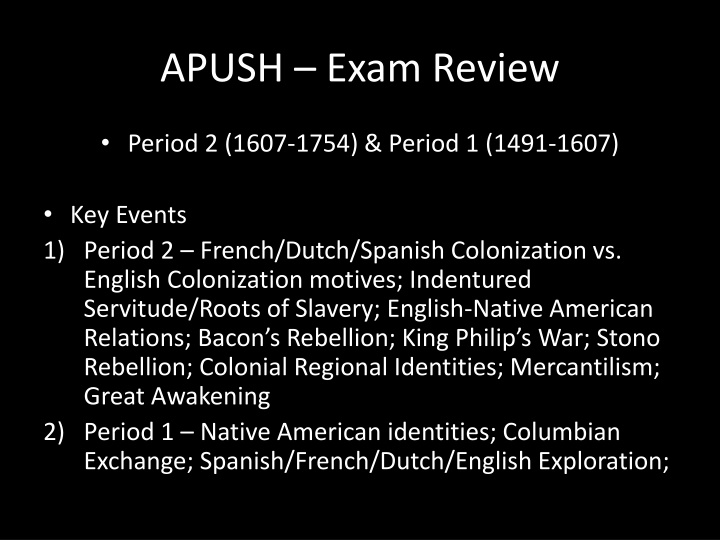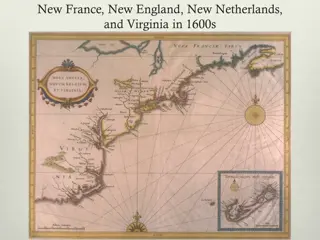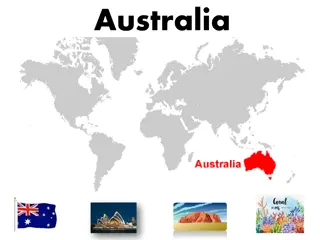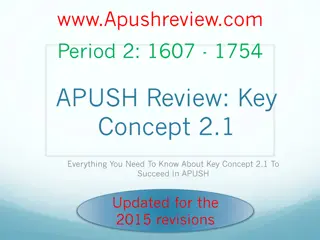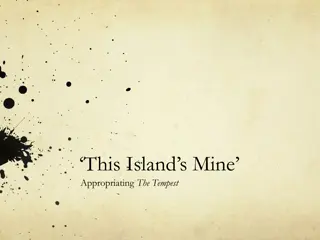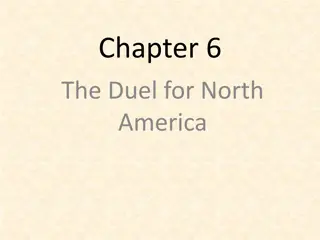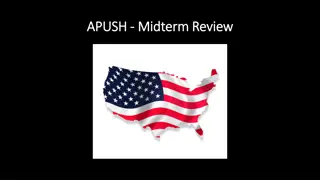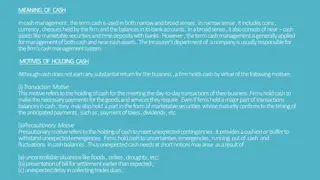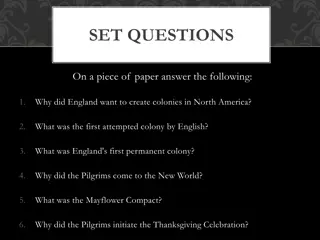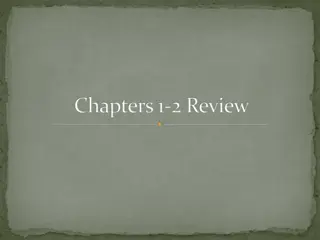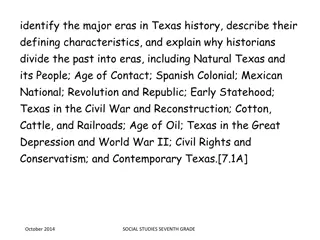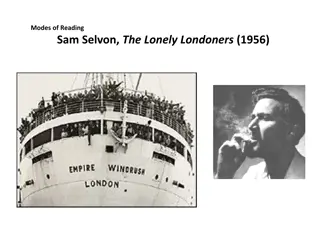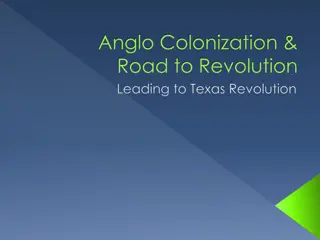Key Events in Early American Colonization: Motives, Interactions, and Consequences
Early American colonization during Periods 1 and 2 (1491-1754) involved various European powers establishing settlements in the New World. Driving factors included economic interests, the use of indentured servitude and the roots of slavery, complex relations with Native Americans, and significant events like Bacon's Rebellion and King Philip's War. The French, Dutch, English, and Spanish each pursued colonization with distinct strategies and impacts, leading to the emergence of varied regional identities and the spread of mercantilism. Additionally, the period saw the rise of significant social movements like the Great Awakening.
Download Presentation

Please find below an Image/Link to download the presentation.
The content on the website is provided AS IS for your information and personal use only. It may not be sold, licensed, or shared on other websites without obtaining consent from the author.If you encounter any issues during the download, it is possible that the publisher has removed the file from their server.
You are allowed to download the files provided on this website for personal or commercial use, subject to the condition that they are used lawfully. All files are the property of their respective owners.
The content on the website is provided AS IS for your information and personal use only. It may not be sold, licensed, or shared on other websites without obtaining consent from the author.
E N D
Presentation Transcript
APUSH Exam Review Period 2 (1607-1754) & Period 1 (1491-1607) Key Events 1) Period 2 French/Dutch/Spanish Colonization vs. English Colonization motives; Indentured Servitude/Roots of Slavery; English-Native American Relations; Bacon s Rebellion; King Philip s War; Stono Rebellion; Colonial Regional Identities; Mercantilism; Great Awakening 2) Period 1 Native American identities; Columbian Exchange; Spanish/French/Dutch/English Exploration;
Period 2: Post-Spanish Success in New World 1) French, Dutch, English all rush to emulate success 2) French = New France stretches from Canada down to Mississippi River and US Southeast to Gulf of Mexico; mainly focuses on profit from fur trade, not on mass migration; DEPENDENT on France and friendly-cooperative relations with Native American tribes for survival/prosperity
Period 2: Post Spanish Success (cont d) 3) Dutch Purely commercial interests (mainly fur trade); settlement of New Amsterdam (Manhattan Island) = Dutch headquarters in N. America; little interest in mass migration 4) Spanish already conquered Mexico, C. & most of S. America by 1600s; outposts in St. Augustine (FL), Santa Fe (NM) and Los Angeles; SW US is considered New Mexico by Spanish gov t; Effects of Pueblo Revolt in 1680 makes Spanish reconsider value of trying to conquer/colonize/Christianize NM
Period 2: Post-Spanish Success (cont d) 5) English late start (internal turmoil in 1500s); population boom between 1550s-1600s = strain on resources; land ownership = prosperity/liberty (origins of mass colonization to N. America, West Indies, and Ireland); N. America = last resort for most; charters are granted to joint-stock companies 6) English motives - profit (gold), religious (save New World from Catholic takeover), prestige (get on par with Spanish/French) US mainland was still open
Period 2: English Indentured Servitude 1) 2/3 of all immigrants could not afford passage; were paid for and contracted by previously-arrived immigrants 2) Expected to work set amount of years to pay off debt (5-7 on average) 3) Subject to possible cruel treatment, extended length of service if not obedience (upheld by courts) 4) Popular in Chesapeake; many died due to disease; survivors were entitled to freedom dues
Period 2: Origins of Slavery: 1) Begun by Spanish to replace Indian population wiped out by disease in W. Indies 2) Lack of familiarity with surroundings, lack of common language, familiarity with agriculture, immunity to European diseases, racism = motivation 3) N. America = slavery arrives in 1619 (same conditions as indentured servitude) but free blacks were subject to strict legal codes of behavior (as opposed to whites)
Period 2: English vs. Native Americans: 1) Big difference English never saw N.A. s as potential subjects or potential laborers ; they were occupying land English wanted; English became chief displacers of N.A. populations more than any other European nation 2) Effect N.A. culture destroyed, subjugated, or heavily modified (language, dress, social standing, cooking, etc.)
Period 2: English vs. Native Americans (cont d) 3) Jamestown survival becomes dependent on Powhatan s generosity; violence in 1622 leads to final showdown with Powhatan s confederacy (ends in 1644 with displacement of remaining N.A. s further west of Virginia) 4) New England N.A. culture too much resembles Catholicism (Puritan belief); feared curious Puritans would leave strict colonies for a free N.A. life; early alliances between English and N.A. tribes fall apart in Pequot War (1637) which opens up CT River Valley to English settlement
Period 2: King Philip s War & It s Impact: 1) 1675 to 1676 results in great devastation for N.E. colonies (destroyed 12 of 24 major English towns and killed 1/8 of N.E. population) 2) Alliance with Iroquois and death of Philip lead to more land gains by English and more westward relocation of N.A. tribes
Period 2: Bacon s Rebellion (1676) 1) VA governed by elite coastal planters (in wake of success of tobacco); gov t was set on good relations with N.A. tribes (preventing westward expansion for newly-freed ind. servs.) 2) Bacon & white/black freedmen object; raid N.A. villages and march on/set fire to Jamestown; rebellion ends in death of Bacon to sickness 3) Impact: white settlers need preferential treatment from gov t/society to prevent a black/white uprising; free blacks are denied freedom dues, ind. serv. times are increased for blacks (intro to chattel slavery); N.A. tribes are pushed out to pacify white frontier settlers
Period 2: Religious Conflict in New England 1) Challenges to strict Puritanism come from Roger Williams (separation of church and state), Anne Hutchinson (condemnation of Puritan dogma/blasphemy), and Thomas Hooker (government power descends from governed, including non-church members) 2) All three were banished from MBC (result is founding of Connecticut and Rhode Island)
Period 2: Stono Rebellion (1739) 1) South Car = always intended to be a slave colony (original settlers migrated from Barbados) 2) As slavery grows, more backlash from enslaved; 100 arm themselves and go on killing spree (2 dozen whites murdered); put down by SC militia; leads to harsher slave codes in SC and other southern colonies
Period 2: Regional Identities New England 1) Plymouth set up as a secular colony with separation of Church and state, allowing all men to vote on issues 2) Mass. Bay set up as a religious-based colony ruled by elect members of congregation 3) NE grows faster due to healthier climate, more balanced gender distribution, and Great Migration (during 1630s-1640s)
Period 2: Mid-Atlantic Colonies 1) NY, NJ, PA, DE 2) All royal charter colonies (set up by Crown) 3) Most are proprietary (owned by a single person or family as reward or debt payment) 4) PA = most ethnically/religiously diverse of all English colonies
Period 2: Chesapeake/Southern Colonies 1) Included great deal of already wealthy landowners from England and W. Indies 2) Social set-up resembled feudal England (landed aristocracy ruled) 3) Tobacco, rice, and eventually cotton made profitable due to rising use of chattel slavery (property for life)
Period 2: Mercantilism At It s Height 1) Definition economy that is controlled, directed by gov t 2) Navigation Acts of 1651 directed that all raw materials/resources developed in colonies were to be exclusively sold to England on English ships and subject to English taxes 3) For the most part followed (b/c of England s naval prowess) but rarely enforced by England (b/c of wish not to disrupt/displease colonists)
Period 2: The Great Awakening 1) Early 1700s traditional beliefs in Puritanism are fading as a result of economic success 2) 1730s Johnathan Edwards, George Whitfield, William Tennent (aka New Lights ) revive religious beliefs emphasizing an emotional connection to and personal inspiration from God. 3) Personal confession to sin was key; ordinary people could read/understand gospel w/o clergy s interpretation 4) Shakes up old society of colonies and leads to development of new beliefs/thoughts (i.e. democracy)
Sample MC Questions 1stStimulus Source: The Burning of Jamestown, Howard Pyle, 1905 (depicting the destruction of the city during Bacon s Rebellion)
1st Stimulus Question 1 The major cause of Bacon s Rebellion was the competing perceptions of power in 17th-century Virginia. Which of the following best describes the differing perceptions? A) The difference in the amount of land available to settlers in the Tidewater (eastern) region and in western Virginia; settlers in the Tidewater had more land B) The competing desires for economic equality and power between the different regions of Virginia C) The difference in political power between eastern plantation owners and the newer settlers in the west, with the advantage going to the eastern plantation owners D) The fact that settlers in the western portion of the colony were mainly former indentured servants with no political rights
Answer: C) The difference in political power between eastern plantation owners and the newer settlers in the west, with the advantage going to the eastern plantation owners Why? The majority of the population had shifted from the east to the west but Virginia s government was not properly representing the political rights of western settlers by refusing to protect them from Native American tribal raids.
1st Stimulus Question 2 The philosophical ideology that led to Bacon s Rebellion would have motivated which of the following groups later in American history? A) South Carolina politicians who supported nullification of the federal tariff in the 1830s B) Western Pennsylvanian farmers who opposed the Whiskey Tax in the 1790s C) Americans in Texas who opposed the conditions Mexico imposed on them in the 1830s D) Abolitionists who were becoming more radically antislavery in the 1850s
Answer: B) Western Pennsylvanian farmers who opposed the Whiskey Tax in the 1790s Why? Most farmers felt that Hamilton s plan to tax them was not fairly representing their best political interests (much like the frontier settlers in western VA)
Sample MC Questions 2nd Stimulus Now the only way to avoid this shipwreck and to provide for our posterity is to knit together in this work as one man, we must entertain each other in brotherly affection so shall we keep the unity of the spirit in the bond of peace, the Lord will be our God and delight to dwell among us, as his own people and will command a blessing upon us in all our ways that may shall say of succeeding plantations: the lord make it like that of New England; for we must consider that we shall be as a City upon a Hill, the eyes of all people are upon us -Source: John Winthrop, A Model of Christian Charity Sermon, 1630
2nd Stimulus Question 1 What city is Winthrop referring to as the City Upon a Hill ? A) Boston B) New York C) Jamestown D) Plymouth
Answer: A) Boston Why? Plymouth and Jamestown had already been established by 1630 and the Puritan congregation he was leading would NEVER want to intermingle with the Dutch in New Amsterdam. Boston became their haven.
2nd Stimulus Question 2 Which of the following supports Winthrop s vision for his City Upon a Hill ? A) He sought to establish a religious society that was accepting of all peoples and different religious beliefs B) He wanted to create a city based on purified Anglicanism and devoted to a Protestant work ethic C) He wanted to establish a religious mission to convert native peoples to Christianity to gain favor within the Anglican church D) He wanted his community to be a successful economic venture to pay off the joint-stock company that financed their voyage
Answer: B) He wanted to create a city based on purified Anglicanism and devoted to a Protestant work ethic Why? Winthrop believed that a religious community based on hard work and piousness would not only survive in the colonies, it would become the envy of all others.
Period 1: Pre-Columbus North America 1) NA tribes were scattered and diverse throughout W. Hemisphere 2) Farmers, hunter-gatherers, fishers; some nomadic, some permanent 3) No livestock, draft-animals, metal tools, machines, gunpowder 4) No belief that land was privately owned; no belief in material possessions = social status
Period 1: Pre-Columbus (cont d) 5) Wars and diplomacy between tribes were constant; confederations existed but each tribe considered itself autonomous 6) No written language, completely oral traditions; high regard for those who possessed healing capabilities 7) Religious beliefs differed regionally, but common elements included omnipotent/omnipresent Master Spirit , afterlife, and a shared world between material and spiritual (including non-human) 8) Most families were matrilineal; men hunted and fished, women worked fields (Europeans looked down upon both)
Period 1: Columbian Exchange & Its Effect 1) Transmission of plants, animals, human beings, pathogens, culture, and technology between Europe, Africa, and Americas (mainly benefitted Europeans) 2) Greatest impact on Native populations disease 3) Ecological impact domesticated animals/livestock/plants introduced into Americas for first time; mass-clearing of land/forests for commercial means 4) Economic/Social Impact a New World ripe with economic opportunity and riches for growing nation- states (Spain, France, Netherlands, England); European populations swelled and lived longer as a more constant food supply was brought from the Americas
Period 1: Impact of the Spanish Conquest 1) N.A.s were seen as subjects to be converted to Catholicism and worked as slaves for benefit of Spain 2) Enconmienda system = land was given to Spaniards by Crown, worked by slaves; owners were obligated to care for slaves; tens of thousands die due to disease, murder, suicide 3) Repartimiento system = begins in 1550; orders N.A. workers to be compensated for labor, legally free from Spanish law; ended Indian slave trade (though rarely enforced)
Period 1: French, Dutch, English Reaction 1) Spain is demonized by rival nations; beginning of the Black Legend 2) By 1520s, French had set sail looking for gold and a Northwest Passage to the Pacific Ocean 3) Dutch arrive in early 1600s for economic gains 4) English attempt but never establish a permanent colony until 1607 (Jamestown)
Period 1: Native American Views vs. European Views 1) Natives saw themselves as more intelligent, resourceful than Europeans (knowledge of land, resources); liked European goods but wanted to maintain own separate identity 2) European N.A.s were noble savages (intelligent, helpful, but un-christianized) or uncivilized brutes ); uneducated due to lack of written language; less intelligent due to inferior technological developments; racially inferior due to skin color; did not use land correctly ; horrified by reversed gender roles
Sample MC Questions 1st Stimulus Maize (corn) swept into Africa as introduced disease was leveling Indian societies. Faced with a labor shortage, the Europeans turned their eyes to Africa. The continent s quarrelsome societies helped them siphon off millions of people. -Source: 1491, Charles C. Mann, pg. 224
1st Stimulus Question 1 The main impact of European exploration on American Indians at the onset of the establishment of the Colombian Exchange was A) The Native population was forced off their land as slave labor was imported from Africa B) The introduction of diseases like smallpox led to a decimation of the American Indian population C) Spanish and Portuguese explorers cut American Indian nations off from trade routes, leading to mass starvation D) The introduction of the horse by the Spanish led American Indians to hunt more and depend upon corn and other crops less
Answer: B) The introduction of diseases like smallpox led to a decimation of the American Indian population Why? It is estimated that 50-90% of the original native population of the Americas perished due to disease introduced by interactions with European explorers and colonists.
1st Stimulus Question 2 The most significant impact of the introduction of sugarcane in the West Indies was A) The need for slave labor from Africa to maintain the constant production of sugar B) The desire of the Spanish to settle the Western Hemisphere with permanent settlements made up of families C) The development of a continuous war between Spain and Portugal over the Caribbean islands D) The destruction of the ecosystem of many Caribbean islands resulting in the death of thousands of natives
Answer: A) The need for slave labor from Africa to maintain the constant production of sugar Why? To maintain constant productivity as well as reap the enormous profits provided by the demand for sugar worldwide (especially as the native populations died out), Spanish and later English colonists in the Caribbean introduced a continuous labor supply of slaves from Africa
1st Stimulus Question 3 As described, the Columbian Exchange was significant in that it had the greatest impact on which group of people? A) Africans: they received the greater variety of foodstuffs from Europe which greatly increased their population B) Europeans: their wealth increased significantly C) Native Americans: they were enslaved by the enconmienda system by the thousands D) Europeans: new, easier to grow foodstuffs such as corn and potatoes were brought from the New World and allowed impoverished population groups to survive and increase their numbers
Answer: D) Europeans: new, easier to grow foodstuffs such as corn and potatoes were brought from the New World and allowed impoverished population groups to survive and increase their numbers Why? Nations such as Germany, Sweden, France, and Ireland with larger numbers of poor grew healthier and lived longer due to the influx of food (increasing in some cases by 500%)
